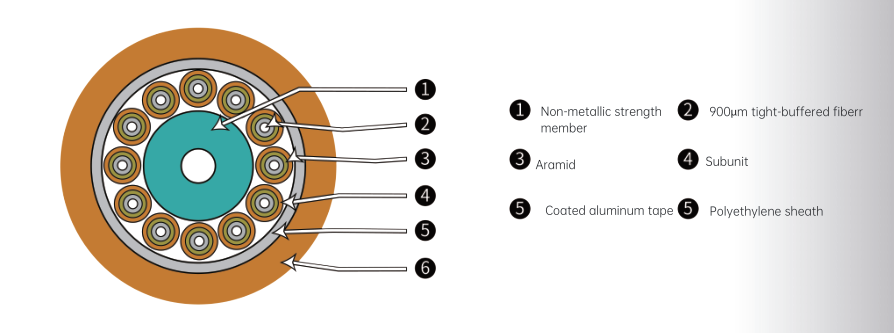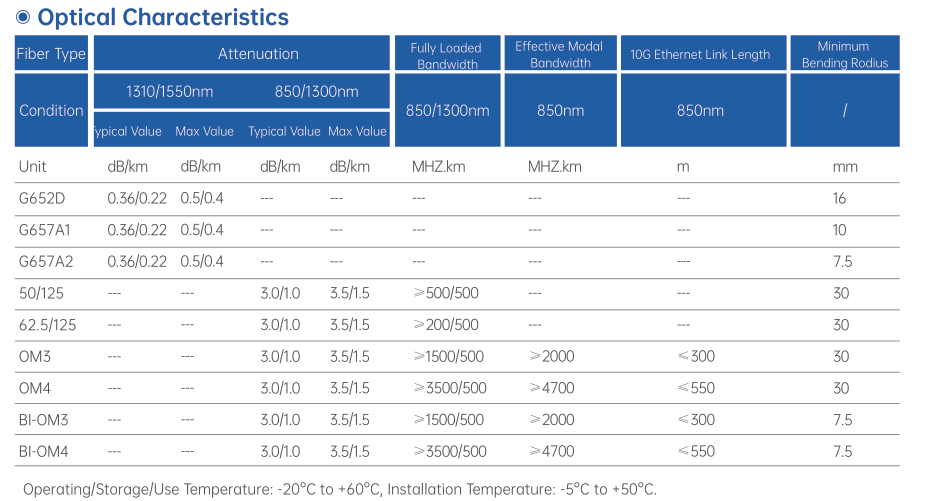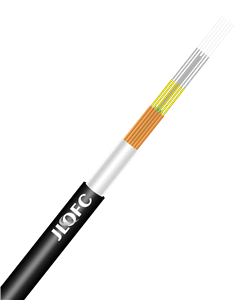In practical applications, GJA optical cable has a clear and wide range of applications. In indoor environments, it is an ideal choice for comprehensive wiring systems. Whether it is the connection of numerous information points in office places or the dense wiring needs inside data centers, GJA optical cable, with its good flexibility and stable transmission performance, can easily achieve efficient data transmission.
Product Description
Waterproof tail fiber uses single-core optical cable (with 900 μm tight-buffered optical fiber and aramid strength
member) as subunit,with non-metallic central strengthening core. The cable subunit layers are twisted around the central strengthening core to form the cable core. It is wrapped with an aluminum foil moisture-proof layer and finally extruded with a layer of polyethylene sheath.
Product Feature
The non-metallic strengthening core enables the optical cable to withstand greater tensile forces.
◆ Aluminum strip has excellent moisture-proof properties.
◆ The outer sheath material offers corrosion resistance,waterproofing,flame resistance,and environmental friendliness.
Product Applications
• Indoor comprehensive cabling
• Connection of outdoor to indoor optical cable distribution equipment



Delivery Length
Recommended Length: 2000m; other lengths can be provided according to customer requirements.
Structural Parameter Characteristics:
Stranded Structure: It adopts a stranded optical cable structure, with a single - core optical cable (Φ900µm tight - buffered fiber, aramid reinforcing element) as a sub - unit, which is stranded around a non - metallic central reinforcing core to form the cable core. This structure enables the optical fibers inside the optical cable to be well protected and also helps to improve the flexibility and tensile resistance of the optical cable. For example, in the actual laying process, the stranded structure can better adapt to different bending environments and reduce damage to the optical fibers.
Non - metallic Central Reinforcing Core: A non - metallic central reinforcing core, such as Fiber Reinforced Plastic (FRP), is used, allowing the optical cable to withstand greater tension. Compared with metal reinforcing cores, non - metallic reinforcing cores have the advantages of light weight, non - conductivity, and anti - electromagnetic interference, making them suitable for occasions with high requirements for electromagnetic compatibility, such as indoor communication equipment rooms.
Aluminum Tape Moisture - proof Layer: The cable core is wrapped with an aluminum tape moisture - proof layer. Aluminum tape has good moisture - proof performance, which can effectively prevent moisture from entering the interior of the optical cable, protect the optical fibers from moisture erosion, and thus ensure the stable transmission performance of the optical fibers.
Polyethylene Sheath: The outermost layer is extruded with a polyethylene (PE) sheath. This sheath has the advantages of corrosion resistance, waterproofing, and UV protection, and can adapt to different environmental conditions from outdoor to indoor, prolonging the service life of the optical cable. For example, in outdoor environments, the PE sheath can resist ultraviolet radiation and prevent the optical cable from aging; in indoor environments, it can also play a certain role in moisture prevention and protection.
Geometric Dimension Parameter Characteristics:
Different Core Counts Correspond to Different Diameters: As the number of cores increases, the diameter of the optical cable increases accordingly. For example, the diameter of GJA - II - YX - 4Xn type optical cable is 8.3±0.5mm, GJA - II - YX - 6Xn type is 9.2±0.5mm, GJA - II - YX - 8Xn type is 10.6±0.5mm, and GJA - II - YX - 12Xn type is 13.4±0.5mm. This size design is to meet the needs of different numbers of optical fibers while ensuring the mechanical properties and construction convenience of the optical cable.
High Dimensional Accuracy: The tolerance of the optical cable diameter is controlled within ±0.5mm, ensuring the consistency and stability of the optical cable during production, which is conducive to the connection and cooperation with other communication equipment.
Weight Parameter Characteristics:
Weight Related to Core Count: The reference weight of the optical cable increases with the increase of the number of cores. For example, the reference weight of GJA - II - YX - 4Xn type optical cable is 58kg/km, GJA - II - YX - 6Xn type is 73kg/km, GJA - II - YX - 8Xn type is 96kg/km, and GJA - II - YX - 12Xn type is 155kg/km. The light weight makes the optical cable more convenient in transportation and construction, reducing labor intensity and construction costs.
Mechanical Performance Parameter Characteristics:
Allowable Tensile Force: It has a certain allowable tensile force. The long - term allowable tensile force ranges from 130N to 200N, and the short - term allowable tensile force ranges from 440N to 660N. For example, the long - term allowable tensile force of GJA - II - YX - 4Xn type optical cable is 130N, and the short - term allowable tensile force is 440N; while the long - term allowable tensile force of GJA - II - YX - 6Xn, GJA - II - YX - 8Xn, and GJA - II - YX - 12Xn type optical cables is 200N, and the short - term allowable tensile force is 660N. This ensures that the optical cable can withstand a certain tension without damage during laying and use.
Allowable Crushing Force: The long - term allowable crushing force is 300N/100mm, and the short - term allowable crushing force is 1000N/100mm. This ability to withstand crushing force enables the optical cable to protect the internal optical fibers from damage when subjected to external extrusion, ensuring the normal operation of communication.
Bending Radius: The dynamic bending radius is 20D (D is the diameter of the optical cable), and the static bending radius is 10D. For example, for the GJA - II - YX - 12Xn type optical cable with a diameter of 13.4mm, its dynamic bending radius is 20×13.4 = 268mm, and the static bending radius is 10×13.4 = 134mm. The small bending radius requirement allows the optical cable to be laid and bent in relatively narrow spaces, increasing the flexibility of its application scenarios.
Optical Characteristic Parameter Characteristics:
Multiple Fiber Types Available: It supports multiple fiber types, such as G652D, G657A1, G657A2, 50/125, 62.5/125, OM3, OM4, BI - OM3, BI - OM4, etc. Different fiber types have different characteristics such as attenuation and bandwidth to meet the needs of different communication rates and distances. For example, the attenuation of G652D fiber at 1310nm and 1550nm wavelengths is 0.36dB/km and 0.22dB/km respectively, which is suitable for general communication transmission; while the effective modal bandwidth of OM4 fiber at 850nm wavelength is ≥3500MHz·km, which can support higher communication rates and is suitable for high - speed communication scenarios such as data centers.
Attenuation Characteristics: Different fiber types have different attenuations at different wavelengths, but in general, they all have low attenuation characteristics, which can ensure the stability and reliability of optical signals during long - distance transmission. For example, the attenuation of G657A1 and G657A2 fibers at 1310nm and 1550nm wavelengths is the same as that of G652D fiber, which is 0.36dB/km and 0.22dB/km respectively, enabling them to maintain good transmission performance in occasions with high requirements for bending performance.
Bandwidth Characteristics: For multimode fibers, such as 50/125, 62.5/125, OM3, OM4, etc., they have different full injection bandwidths and effective modal bandwidths. For example, the full injection bandwidth of 50/125 multimode fiber at 850nm and 1300nm wavelengths is 3.0GHz·km and 1.0GHz·km respectively, and the effective modal bandwidth is ≥500MHz·km and ≥500MHz·km respectively, which can meet the needs of Ethernet transmission at different rates.
Environmental Adaptability Parameter Characteristics:
Operating Temperature Range: The temperature range for transportation, storage, and use is -20℃ to +60℃, and the installation temperature range is -5℃ to +50℃. The wide temperature range enables GJA waterproof pigtails to adapt to environmental temperature changes in different regions and seasons, and can be used normally in cold and hot regions.
Ability to Handle Complex Systems:
Non - linear Adaptability: The GJA method can handle non - linear, time - varying, and complex system dynamics models. In the actual risk assessment of systems, many systems show non - linear characteristics. For example, the chemical reaction systems in some chemical production processes have non - simple linear relationships between their parameters. The GJA method can describe this complex non - linear relationship by constructing a generalized set pair matrix, thereby more accurately assessing the risk of the system.
Dynamic Processing: The GJA method also has good adaptability to time - varying systems. For example, in power systems, the risk of the system changes dynamically with the change of load and the aging of equipment. The GJA method can assess the dynamic risk of the system by updating data in real - time and adjusting parameters.
Robustness Characteristics: The GJA method has good robustness to noise data and non - Gaussian parameters. In the actual data collection process, it is often disturbed by various noises, and the distribution of data may not conform to the Gaussian distribution. The GJA method can suppress the influence of noise to a certain extent, and even if there are errors or noise interference in the parameter estimation process, it can maintain the stability of the system and give relatively accurate system risk assessment results. For example, when analyzing the fault data of some industrial equipment, the data may have noises such as measurement errors, but the GJA method can still effectively extract the characteristic information from the data and assess the risk of the equipment.
Interpretability Characteristics: The GJA method describes the risk of the system by constructing a generalized set pair matrix, and this matrix structure makes the interpretation of the model simple and clear. At the same time, by calculating eigenvalues and eigenvectors, we can intuitively understand the key factors and potential risks of the system. For example, when assessing the risk of a city's natural gas transmission and distribution network using the GJA method, the generalized set pair matrix obtained can clearly show the relationship between various risk factors, and the factors corresponding to the eigenvectors with larger eigenvalues are often the key factors affecting the risk of the network, such as pipeline corrosion and third - party damage, which is convenient for managers to take targeted measures to reduce risks.
Flexibility Characteristics: The GJA method can be applied to various types of systems, including linear, non - linear, time - varying, and fuzzy systems. This makes the method highly adaptable and able to meet the needs of system risk assessment in different fields and scenarios. For example, in the field of traffic safety, it can be used to assess the risk of road traffic accidents; in the field of environmental science, it can be used to assess the risk of environmental pollution incidents.
Computational Complexity Characteristics: Compared with other evaluation methods, such as the vulnerability index method and the risk matrix method, the GJA method is relatively cumbersome in calculation. It needs to construct a generalized set pair matrix and calculate eigenvalues and eigenvectors, which may increase the calculation cost and time for large - scale systems or assessment scenarios with high real - time requirements. For example, when conducting real - time risk assessment of a large and complex industrial system, the calculation amount of the GJA method may be large, requiring high - performance computing equipment for support.
Parameter Sensitivity Characteristics: The performance of the GJA method is greatly affected by the values of the eigenvalues and eigenvectors of the generalized set pair matrix. When these parameters change, it may lead to significant deviations in the assessment results. Therefore, when using the GJA method, it is necessary to carefully select parameters and make reasonable adjustments. For example, in different application scenarios, it is necessary to determine appropriate parameters according to specific data characteristics and system characteristics to ensure the accuracy of the assessment results.
Data Dependence Characteristics: The GJA method relies on the accuracy of parameter estimation, so it has high requirements for the quality and quantity of data. If the data is biased, missing, or inaccurate, it may affect the results of parameter estimation, thereby leading to errors in the assessment results. For example, when conducting system risk assessment, if the collected fault data is incomplete or incorrect, the risk assessment results obtained by the GJA method may be unreliable.












